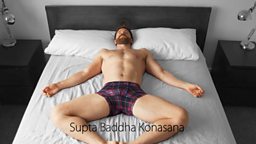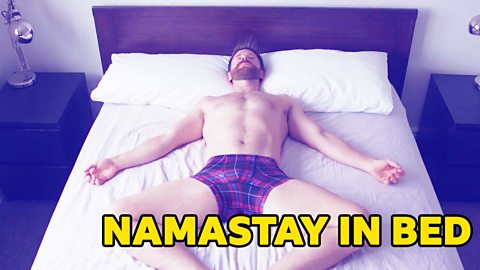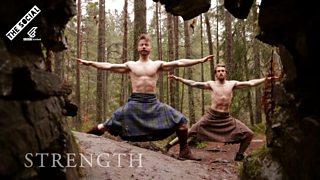Namastay in bed! Try some mattress yoga to ease yourself into a better day ...or to fall back asleep — either’s good
30 July 2018
Waking up all snug in bed can be a great time to move into some easy yoga postures. You’re already lying down and your mind should be quiet and calm. Try these postures recommended by Finlay Wilson, aka .
The suggestions here contain only basic guidance. If you have any medical issues, consult a doctor before attempting. Seek out a trained yoga teacher to learn the basics.
Reclining Lord of the Fishes (Supta Matsyendrasana)

How to do it
- Lie flat and straight on your back, exhale and press your lower back to the mattress;
- Gently contract your abdominals, bend your knees and lift your feet;
- Stretch your arms into a ‘T’ shape, palms down;
- Lower your legs together to the right and look to the left;
- Hold this stretch for 30-60 seconds and then turn to the left and repeat.
Fun fact: Matsyendranath, the Lord of the Fishes, was a 10th Century yogi and Buddist saint considered the founder of .
Child’s pose (Balasana)

How to do it
- Begin on your knees with your big toes touching;
- Separate your knees as wide as your hips;
- Lower your torso between your thighs;
- Lengthen your tailbone towards your heels and extend the base of your skull from the back of your neck;
- Lay your arms out in front of you with the palms down;
- Rest for as long as you like — focus on resting ‘deeper’ into the hips.
If you have any issue with your knees or ankles, you should take care in the pose and consider contacting a medical professional for advice.
Reclining Bound Angle Pose (Supta Baddha Konasana)

Stay in this pose for around a minute. Over time, you can extend how long you are in this posture for up to five or even ten minutes. To come out, use your hands to press your thighs together, then roll over onto one side and push yourself away from the floor, head following the torso.
If you feel any strain in the inner thighs and groin, support each of your thighs on pillow or blanket. Make sure each support is the same height.
How to do it
- From a seated position bend your knees and pull your heels in toward your pelvis
- Gently drop your knees out to the side and press the soles of your feet together
- Bring your heels as close to your pelvis as you comfortably can
- Clasp each hand around the outside of each foot or shin
- Lengthen the front torso through the top of the sternum
- Gently release thighs toward the floor
- Move your arms to your sides and lean on your hands
- Lower your back torso toward the floor
- Release your lower back and upper buttocks through your tailbone
- Bring your torso all the way to the floor, supporting your head and neck on the pillow
- Lay your arms on the floor, angled at about 45 degrees from the sides of your torso, palms up
One-legged King Pigeon posture (Eka Pada Rajakapotasana)

How to do it
- Begin on your hands and knees, with your knees directly below your hips and your hands slightly ahead of your shoulders;
- Slide your right knee forward to the back of your right wrist, angle your shin under your torso and bring your right foot to the front of your left knee;
- Slowly slide your left leg back, straightening the knee and descending the front of the thigh to the mattress;
- Lower the outside of your right buttock to the mattress;
- Position the right heel just in front of the left hip;
- Extend your left leg straight out of the hip;
- Gently lay your torso down on the inner right thigh for a few breaths, stretching your arms forward.
Frog Pose (Mandukasana)

NOTE: If this pose is too intense, you can take Half Frog Pose: Ardha Mandukasana. Do this by adjusting the pose by bringing your knees wide, and your feet towards one another, with the tops of your feet facing down.
How to do it
- Sit on your heels, making sure your knees are touching as well as your big toes;
- Roll your torso forward and over your knees;
- Press your big toes together and begin to move your knees as wide apart from one another as they will comfortably allow;
- Move one at a time — don’t strain your knees or hips as this will lead to injury;
- Flex your feet and bring the inside edges to touch the mattress;
- The angle in both the knees and ankles should be no greater than 90 degrees;
- Sink down into your pelvis, allowing your chest to drop into the floor and feel your hip joints open;
- Press your weight into your elbows, relax your belly;
- Draw your shoulder blades towards one another while pushing your hips back.
Namastay in bed yoga poses

Namastay In Bed Yoga Poses!
Yoga poses you can do from your bed!
Sleep and yoga around the ´óÏó´«Ã½
-
![]()
-
![]()
Anywhere Yoga
From ´óÏó´«Ã½ #MakeYourMove

Latest features from ´óÏó´«Ã½ Scotland
-
![]()
'Wild swimming helps me process the grief of losing my son'
The benefits of cold water therapy.
-
![]()
Winter adventures are appealing, but an expert advises caution
Trips in winter require particular knowledge and skills.
-
![]()
The rescuers: Why volunteers risk their lives in mountain emergencies
Landward meets members of the Cairngorm Mountain Rescue Team.
-
![]()
‘Look for the light’ – practical tips to help you through another winter with SAD
Useful advice and tips to combat low moods at this time of year.
-
![]()
How you could be a binge drinker without even knowing
Binge drinking is classed as fewer units than many people may realise.
-
![]()
How chocolate biscuits and drama classes helped one man leave prison behind
The healing power of creativity.
-
![]()
'When people believe in you, it’s life-changing'
Author Graeme Armstrong revisits the man who helped turn his life around.
-
![]()
The 'breath-taking' display of US birds swept on to British soil
Recent storms have brought rare birds to our shores.
-
![]()
Six things we learned about Alan Cumming on Take the Floor (Spoiler: includes accordions)
The actor spoke to Take the Floor's Gary Innes.
-
![]()
How street gangs trap young men in a dangerous cycle of violence
The almost inescapable pull of life in a gang.
-
![]()
Why stylist Gok Wan believes there's no such thing as bad fashion
The fashion expert says we should stop following rules and do what feels right.
-
![]()
Is sending a CV still the right way to apply for a job?
They've been central to job applications for years, but are they worth it?



















